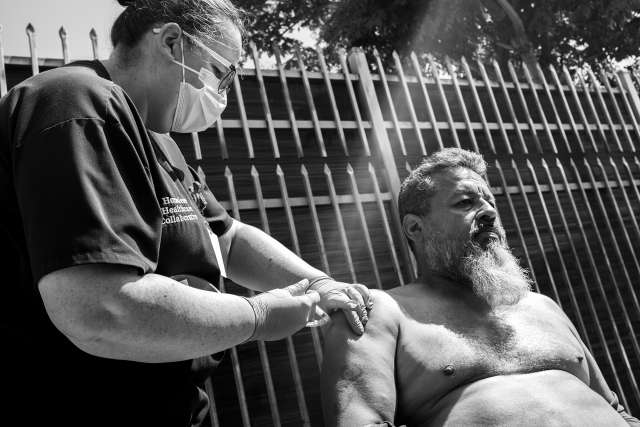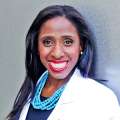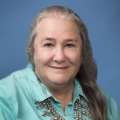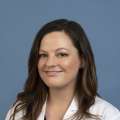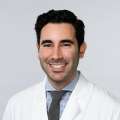On a Saturday afternoon this past spring at a neighborhood park in Santa Monica, a park “ambassador” approached Kendal M. Wilkie, RN, and told her about a man who appeared to be asleep on the cement floor of the restroom. He’d been there for nearly an hour, the ambassador said.
Wilkie and UCLA Health emergency department physician Natasha Wheaton, MD, who were in the park with a team of UCLA health care workers to deliver medical services to people experiencing homelessness, followed him to the restroom, where they found the man unconscious in a tiny, dimly lit cubicle. His inert body was blocking the door and had to be pushed aside to get it open.
The man, perhaps in his 50s and dressed in jeans and a polo shirt, wasn’t sleeping; he had overdosed and was barely breathing. His skin was greyish, and he was cyanotic, his lips turning blue. What appeared to be drug paraphernalia was on the ground next to him.
“It was obvious,” Wilkie says. “He was very much in need of urgent assistance.”
Wilkie and her colleagues were at the park that day as part of the recently launched UCLA Health Homeless Healthcare Collaborative. They were getting ready to move on to their next stop when the ambassador approached.
While Dr. Wheaton stayed with the man and began maneuvers to stimulate his breathing, Wilkie ran back to their van to retrieve a dose of Narcan to reverse the effects of the overdose. A passerby in the park saw what was happening and called 9-1-1.
“He woke up a little bit when we gave him the Narcan. Luckily, the paramedics got there straightaway,” Wilkie says. “They pulled him out of the bathroom and gave him another dose or two of Narcan, and he came fully around.”
Wilkie believes that if the UCLA team had not been there, the ending to the man’s story would have been tragically different. “Without intervention, he would have died,” she says.
Addressing health care disparities
As the COVID-19 pandemic revealed the depths of health care disparities throughout the country, UCLA Health joined with community-health and social-service organizations to establish the UCLA Health Homeless Healthcare Collaborative. It started in January with a fleet of specially equipped vans to provide primary- and urgent-care services to street, shelter and interim-housing sites throughout the city. Services include preventive care, screenings, vaccinations, wound care, assessment and monitoring of chronic diseases, behavioral-health screenings, prescriptions, lab services and specialty-care referrals and coordination.
“We hope that by creating this durable structure to expand access to comprehensive, high-quality health care and social services we can play a significant role in improving the lives of so many people who too-often fall between the cracks,” says Johnese Spisso, MPA, president of UCLA Health and CEO of the UCLA Hospital System. “At UCLA Health, we see firsthand the detrimental health consequences that can be brought on by homelessness. Providing quality care not only improves the overall health of people experiencing homelessness, it also improves their chances of receiving housing and employment opportunities.”
For the UCLA health care workers such as Wilkie and Dr. Wheaton staffing the vans, the work can resonate with deeper meaning.
“We are seeing an under-resourced population that desperately needs care and attention and who have been overlooked in the past,” Wilkie says. “It brings up a lot of emotions, really. So many of these people have had bad experiences in the past with the health care system, and they are frightened and distrustful. Whatever we can do to make that a better, more positive experience for them is so important. We don’t judge anyone. We come to where they live to care for them no matter what their need is.”
California has the largest number of people experiencing homelessness in the country, an estimated 160,000. There are more than 66,000 unhoused people in Los Angeles County, with more than 41,200 in the Greater Los Angeles area. It is believed that the COVID-19 pandemic has caused an increase in the number of people experiencing homelessness due to unforeseen economic hardship.

“Our unhoused neighbors are still our neighbors,” says Brian P. Zunner-Keating, RN, director of the UCLA Health Homeless Healthcare Collaborative. “They need to be treated with dignity and respect. In some ways, I wish our program didn’t have to exist. I feel that health care is a human right, and we should be able to deliver efficient, effective, equitable care to everybody. But this is the reality in which we live.”
Inspiring new hope in health care
Sometimes what might seem like a simple intervention can change a person's life. Wilkie recalls one patient at a transitional-housing facility for people awaiting more permanent homes. The man was losing his vision, and “he assumed he was going blind and it was just something that he had to accept,” Wilkie says.
A UCLA Health social worker, Selina M. Nuñez, got involved with the man’s case, “and she really advocated for him,” Wilkie says.
Because he was from Washington, the man had no local identification or medical insurance. “He was facing every barrier to care,” Nuñez says. “The case manager at the site said they were unable to confirm his identity because he lacked a birth certificate.”
Nuñez and the collaborative team brought in the UCLA Mobile Eye Clinic and scheduled an eye exam for the man. They learned that this patient wasn’t going blind — he had cataracts.
In May, the man underwent surgery — at no cost to him — and his vision was improved.
“It instilled hope in him,” Nuñez says. “Sometimes the biggest part of our job is to help folks build back their hope. It can be hard to see the light at the end of the tunnel when the things happening in their lives are so difficult.”
Community is everything
On a side street off of Venice Boulevard is an encampment of tents, tarps and cars. “Let’s see if we can get him to come out of the tent,” says Mary M. Marfisee, MD, a family-medicine physician with two decades of street-medicine experience who is clinical medical director of the UCLA Homeless Healthcare Collaborative, as she approaches a dwelling. Getting people to come out of their shelter is crucial to understanding their well-being. Dr. Marfisee recalls a patient whose spine condition was so bad that he could not stand up to walk out of his tent. Fortunately, a resident physician was there to lift him onto a nearby broken office chair. It was then that they knew it was time to call paramedics.
Reluctant at first, the patient on this day knows Dr. Marfisee’s voice and trusts her enough to come out. He is an unhoused man in his 50s who shares a pair of tents with his girlfriend. An overturned red patio umbrella separates the tents from scattered belongings that include a collection of grocery carts filled with boxes; a bicycle leaning against a tarp; an unplugged floor lamp; and a make-shift plywood table topped with vitamins, canned food, jugs of water and a snake plant.
The man has irritant contact dermatitis, a condition that surely has worsened due to his poor living situation. Such conditions, as well as blisters, sores and open wounds, are common among people living on the street. Nancy Vega, RN, and Dr. Marfisee patiently and with evident kindness listen to the patient as he describes all of the home remedies he has tried. They give him a steroid cream and instruct him to apply it to his leg twice a day.
“We’ll be back next week,” Dr. Marfisee says as she and Vega move on to the next tent. “Continuity is everything. If we say we’ll be back, we’ll do it no matter what.”
The next tent is home to a pregnant woman and her boyfriend. Dr. Marfisee calls out the woman’s name, but there is no answer. Still, Dr. Marfisee promises out loud that she will come back.
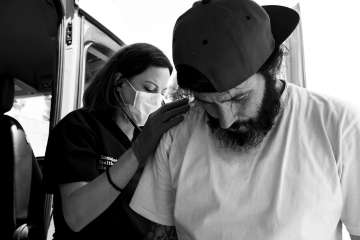
“Some of this population move around the city,” says Catherine M. Weaver, MD, administrative medical director of the UCLA Health Homeless Healthcare Collaborative. “I’ve run into patients in Santa Monica who say their primary care is located in Glendale. How easy do you think it is for someone who already lacks access to resources to get from Santa Monica to Glendale for an appointment at 3 p.m. on a Thursday?”
Many times, homeless patients end up in the ER. At the start of the COVID-19 pandemic, UCLA Health Quality Management Services and the UCLA Health Office of Health Equity, Diversity & Inclusion began analyzing data and found that over the past five years, UCLA Health emergency departments treated around 15,000 homeless individuals for various medical, psychiatric and social needs. Of those visits, 85% were due to primary- or urgent-care conditions that can be prevented or treated in a community setting, while 15% required specialty care or inpatient admission.
At the same time, an anonymous donor approached UCLA Health about funding a project to address care for people experiencing homelessness. “We combined the donor’s vision with our data and a multidisciplinary team to think strategically about how we can effectively address the health care and social needs for this population. The timing was perfect, and there was great synergy,” says Medell K. Briggs-Malonson, MD, co-executive sponsor of the collaborative and chief of Health Equity, Diversity & Inclusion at UCLA Health.
“Everyone should have access to high-quality health care, but the playing field is not even,” adds Janet Rimicci, RN, senior director for UCLA Santa Monica Medical Center and co-executive sponsor of the collaborative. “In order to get to an equitable place where everyone has that access to health care, you have to adjust and tailor the approach not just for each population, but for each individual.”
While there are several UCLA initiatives to provide care to people experiencing homelessness — including the Student Run Homeless Clinics, of which Dr. Marfisee has been the program director for nearly two decades; the UCLA Fielding School of Public Health’s student-run Mobile Clinic Project, which has been delivering care on the streets of Hollywood for more than 20 years; and, with the Los Angeles County Department of Mental Health, the DMH + UCLA Public Partnership for Wellbeing — the model for the UCLA Health Homeless Healthcare Collaborative has a different structure, Dr. Briggs-Malonson says.
“We envisioned a highly professionalized care-delivery model when we created the UCLA Health Homeless Healthcare Collaborative. It was important to us that the care that we provide on the street be the same high-quality, compassionate care that we, as UCLA Health, provide in our brick-and-mortar clinics, emergency departments and hospitals,” Dr. Briggs-Malonson says.
That model led to the creation of a three-phased approach to bring board-certified health care providers and equitable care services directly to the patients. It began with a pilot launch of two vans to bring services to West Los Angeles, South Los Angeles, Downtown L.A. and North Hollywood. The second phase, which is expected to launch in the fall with six vans, will expand primary- and urgent-care services and will include psychiatry and other specialty services. Physicians or nurse practitioners will remotely assist some of the nurse-led teams in the field.
Phase three will further integrate the collaborative’s specialty-care services with those of federally qualified health centers, other health care providers and social-service partners to appropriately and effectively attend to the health and social needs of patients that cannot be addressed with a mobile clinic. This includes diagnostic studies, specialty care and additional enhanced case management.
“We cannot do this alone,” Dr. Briggs-Malonson says. “We pride ourselves on building strong partnerships.” She acknowledges that UCLA Health is not the first institution to marshal teams of health care professionals to deliver services to those experiencing homelessness. The UCLA-affiliated Venice Family Clinic and the Keck School of Medicine at USC both have well-established programs.
“We respect the work that has been done by these and other organizations for decades,” Dr. Briggs-Malonson says. “We are not here to compete — we are joining them in this important work fighting the health care and social ills that plague those who are experiencing homelessness, filling in the gaps in primary and specialty care that others may not be able to provide and doing our best to connect our patients to housing resources.”
Trust is at the heart of homeless health care
Marcia Ann Santini, RN, can't get the woman covered in lice out of her mind. It was a hot day, and there she was, sitting in the grass on a residential street near a nursing home in South Los Angeles. “From a distance, it looked like she had measles,” the veteran emergency-room nurse recalls. “As we got closer, we saw that the bumps she was scratching at actually were lice. There were body lice head-to-toe.”
In more than three decades of nursing practice, Santini had never seen anything like it. “I immediately went into ER-mode,” she says. “She needed to go to a hospital.”
While Santini believed that immediate medical care was necessary, the woman didn’t want it and refused any treatment. It would take time and patience to gain her trust.
Trust, Santini learned, is at the heart of street medicine.
She and her UCLA Health Homeless Healthcare Collaborative team came back the following week, and this time the woman allowed Santini to draw blood and wash her hair. They gave her food, clothing and new bedding, but didn’t see her again after referring her to another street-medicine team for continuity of care.
“I don’t think this case will ever leave me,” Santini says. “It’s like reading a book or starting a movie and not finishing it. I want to know how it ends. I want to know where she is and how she is doing.”
Moving forward while facing limitations
Everett is 62 years old and recently homeless. He spent a month living on the street and the past several weeks in a downtown shelter for men. Wearing a white T-shirt, gray basketball shorts, black-and-red sneakers and a disposable facemask, Everett sits down at one of the black picnic tables where the UCLA Health Homeless Healthcare Collaborative team has set up for the morning.
Dr. Wheaton asks Everett if he’d like to have his blood pressure checked and if he has any aches or pains that he wants to talk about with her. Everett is living with insulin-dependent diabetes. In addition to having had a stroke, he tells Dr. Wheaton that he also has a heart condition. For the past two months, Everett has been off his medications because they have been locked up in storage due to his housing situation.
Nurse Vega checks Everett’s blood pressure and draws blood for a metabolic panel and an A1C test to measure his blood-sugar levels. He grimaces when Vega pricks his finger. She then walks the sample back to the van to be analyzed.
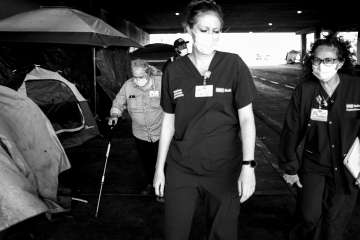
In the meantime, Dr. Wheaton contacts Everett’s primary-care physician to get a list of his medications. The physician tells her that Everett is on several medications and recently had a checkup. Dr. Wheaton is relieved to hear that Everett is established with a primary-care provider and that the doctor’s office was able to refill and route his medications to the shelter.
When Vega comes back, she informs Everett that his A1C is normal, and it has, in fact, come down from the numbers that his doctor provided over the phone. “Keep up whatever you’ve been doing,” she tells him, smiling beneath her mask.
Everett responds that he’s been minding what he eats and exercises when he can. He adds that he often gets breakfast at Denny’s with his girlfriend and 11-year-old son, who are staying in a neighboring shelter. “I usually get the pancakes with the sugar-free syrup or a vegetarian omelet,” he says.
With Everett’s medication refills back on track, the medical team counts this as a small victory. “While our vans are fully equipped with a pharmacy, labs and many medical supplies, we’re still in a van and there’s only so much we can do,” Dr. Briggs-Malonson says.
That, she says, “has been the greatest challenge — facing our limitations while still trying to make sure that all of our patients receive the medical, social and housing services that they need to thrive.”
Pairing medical and social services
To critics who might say that street medicine is nothing more than a Band-Aid, Faysal Saab, MD, has a response. “Sometimes if you don’t put a Band-Aid on a problem, it gets worse,” says Dr. Saab, associate director for UCLA Health’s internal medicine Global Health Pathway. “Sometimes a Band-Aid can be very effective in terms of stabilizing a patient. Maybe street medicine can’t help everybody, but for some people, it can make all the difference.”
Dr. Saab adds that “we recognize lack of access to affordable housing is the most significant underlying problem leading to homelessness, but while local officials are working on solutions to that issue, we need to step in and address the existing health problems of this population so they do not get worse in the interim. As health care providers, it is incumbent on us to do our best to reach out to those in need in our community so that people do not suffer more than they already have.”
The combination of medical and social services can have a powerful impact on the street. “When you pair social services with a nurse or a doctor — someone asking about their pain, their health problems, while sitting on the sidewalk with them and cutting their toenails so they can walk again — that looks and feels very different for a human being,” Dr. Saab says. “It feels like someone is caring for you and wanting to help you.”
It all comes back to trust. “If they know you’re going to come every week, then they trust you,” nurse Santini says. “They see that you care. I was cutting someone’s toenails and I started to rub their feet and … the look in their eyes.”
For a moment, Santini can’t speak and she wipes away tears.
“Listening is huge,” she continues. “Just allowing them to tell their story or talk about whatever they want to talk about. It’s a different type of nursing, right? You don’t have to be treating a wound or taking someone’s blood pressure — you just listen. That means so much to them.”
This article originally appeared in the Fall 2022 edition of U Magazine.
